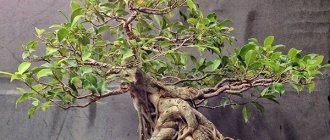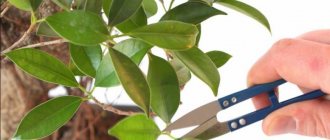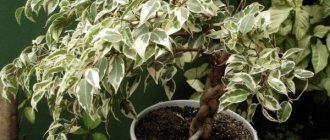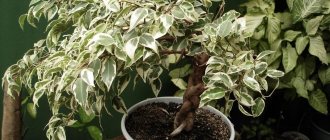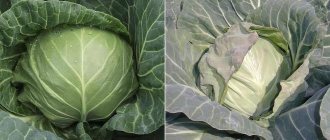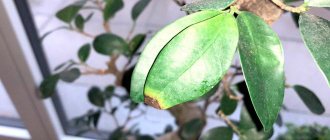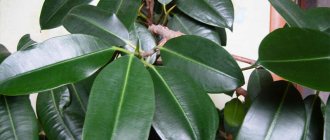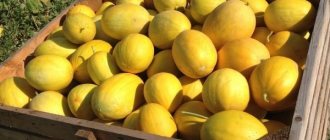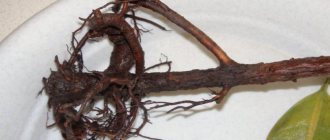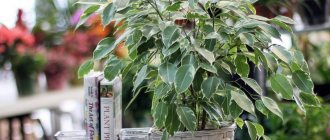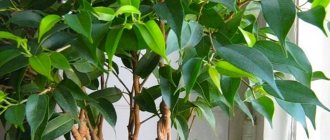Ficus trees are popular; these plants can often be found in home greenhouses. Beautiful plants that look like a mini-tree, are distinguished by the oily shine of their leaves, the variety of their colors and the variability of crown formation.
Ficus Benjamin varieties: Natasha and Kinky are dwarf varieties of this plant . Miniature trees are quite often used in bonsai style, for interior decoration or as a natural air purifier.
Caring for these varieties, as well as caring for Ficus Benjamin, is very similar.
Photo gallery
It has an invasive root system; in the natural environment it grows up to 10–15 m, but at home it does not exceed 40–50 cm.
It has a beneficial effect on indoor air, converting benzene and phenol into amino acids.
In places where leaves or shoots are damaged, it produces milky sap, which is not only poisonous to pets and people, but can also cause allergic reactions upon contact with it.
Possible difficulties during cultivation
The appearance of diseases and pests is often associated with violations of ficus care.
Did you know? Feng Shui experts say that a ficus located on the southeastern side of a home will give its inhabitants the ability to think wisely and relieve aggression. A specimen located in the kitchen will attract money into the house, and one growing in the bedroom
-
will relieve insomnia.
Let's look at the main difficulties that you may encounter when growing this plant:
- If the foliage withers, then it is necessary to moisten it, since this phenomenon occurs due to a lack of moisture.
- Yellowing and falling of leaves often occurs due to overwatering and excessive soil moisture. Watering should be reduced and the soil in the pot should be allowed to dry.
- If the color of the leaves becomes discolored and the growth of the plant slows down, then it is necessary to fertilize or replant the plant and inspect the root system.
- Dark brown spots appear on the leaves, they fall off - this means low air temperature in the room. The flower needs to be moved to a warmer room or the air temperature in the place of growth should be increased.
- The appearance of mealy white formations on the underside of the leaf indicates the presence of a mealybug. The leaves should be washed with a sponge soaked in soapy water and the insecticidal preparation Aktara should be applied.
- The appearance of a thin web and patches of reddish color on the leaves indicates the appearance of a red spider mite. Treatment is carried out using Aktara or Sunmite. They also increase the humidity in the room, since dry air provokes the development of these pests.
- When brownish growths appear on the leaves, you can guess that the plant is affected by a pest such as scale insects. The leaves are cleaned with cotton wool soaked in alcohol, or treated with the Actellik insecticidal agent.
If you follow all the rules for caring for the Tineke ficus and provide it with all the necessary conditions, then this flower will delight you with its exotic appearance for a long time.
Signs and superstitions
There are many signs associated with this plant, and in Thailand it is considered sacred, believing that its owner will have good luck in all endeavors.
The beliefs of different peoples are similar in that ficus is able to rid the house of any manifestations of negativity, normalize the nervous system of the owners and improve their mood.
People who have this tree growing in their house will get rid of fatigue, gain confidence in their abilities, and begin to look at the world around them much more positively.
Ficus will help improve your material well-being if you plant it in a green flowerpot, bury a few coins in the ground, provide the tree with proper care and regularly ask for help.
Another ability of the ficus that contributes to its popularity and spread is its assistance in finding love, establishing strong and trusting relationships between spouses and conceiving a child for couples who have long dreamed of this.
Is ficus poisonous?
In addition to negative superstitions, the flower has gained unpleasant fame from the statement that it is poisonous. Many people think about this before purchasing a ficus, and therefore it is worth understanding this issue.
Ficus is indeed poisonous, but only for those who are allergic to such plants. The fact is that during the process of growth, the flower secretes a special milk. Its release contributes to the exacerbation of allergic reactions in those who are susceptible to a similar problem.
In this regard, sometimes purchasing a ficus for your home becomes a truly undesirable decision, and it is better to replace the indoor flower with another one to which you are not allergic. Otherwise, the secreted juice can cause not only irritation, but also cough and asthma. Situations also arose when a person developed a fever as a result of an allergic reaction.
Some people may be allergic to ficus
But this does not mean that the plant is dangerous for others. No, the flower will only cause problems for those who are hypersensitive to the substances contained in Natasha’s milk. In all other cases, the plant will not only not be considered poisonous, but will also bring benefits to the house, playing the role of a certain filter.
In the process of growth and development, ficus rids the air of negative substances and produces huge amounts of oxygen. That is why it is recommended to plant the plant in the homes of those who live in large cities that are quite polluted with exhaust gases.
Thus, ficus is a tree that has a rather versatile “reputation”. The choice of which signs to believe in depends only on who decided to acquire this flower. However, it is worth noting that if you believe only in good things and take care of the plant, it will definitely improve the atmosphere in your home.
Is it suitable for shaping bonsai?
Regular pruning allows you not only to awaken dormant buds and increase the splendor of the crown, but also to give it any shape. The most common option is a tree on a trunk, which is a straight bare trunk, decorated with a spreading dense crown.
Ficus weaving is also popular among gardeners - the ability to form various shapes from ficus trunks in the case of planting several specimens in one flowerpot. So, for braiding you will need 3 shoots, for a spiral 2, for a lattice - at least 6.
Is your Ficus Benjamina Natasha growing?
You can also use ficus to form bonsai. The main goal is to limit root growth by planting the plant in a small flat pot and regularly trimming the roots. The branches and trunk can be given direction using wire.
Difficulties in growing the Benjamin Natalie flower
The most difficult thing is to choose a suitable place for such a capricious plant. Here are some recommendations on which place to choose:
- air humidity about 50%;
- temperature - 23-25 degrees;
- distance from the battery is at least 1 meter;
- far from open windows and doors;
- the entire crown should be illuminated evenly;
- You should not constantly move the pot, as the ficus prefers to be in one place.
Attention! It is important to choose the right microclimate. If Ficus Benjamin Natasha stays in the shade for a long time, he will get sick. With severe light deficiency, leaves stop growing
With severe light deficiency, leaves stop growing.
Quite a lot of difficulties arise due to the fact that it often has to be sprayed and periodically placed under the shower. If not properly cared for, it stops growing. There is also a risk of developing various diseases. They develop quickly, completely destroying the plant.
From time to time you may encounter this problem. Leaves may turn yellow:
- Incorrect watering. Due to the large amount of moisture in the soil. You can try not watering the ficus for a while. Also, do not turn the pot. If after 5-7 days there is an improvement, then this is the reason. If there is no improvement, then the plant needs to be replanted. Some roots will be rotten. They are removed with a knife.
- Cold. A slight draft, a sudden change in temperature or cold water for irrigation is the cause of yellow leaves that will fall off. So that he does not face the cold.
- Replanting is stressful, so be prepared to lose a few leaves. It is normal that the ficus will need some time to adapt.
- Lack of microelements. Magnesium, iron and nitrogen are required in sufficient quantities for normal growth and development. Fertilize according to instructions in spring and summer. Excessive amounts of minerals are another cause of yellowing and leaf drop.
- Pests. They are easy to detect upon superficial inspection. It is necessary to get rid of them with fungicides or other poisons.
- Diseases. They are accompanied not only by yellowing of the leaves.
Darkening of the stem
Most often, the trunk darkens due to the following reasons:
- sudden change in microclimate;
- the appearance of root rot;
- mealybugs and spider mites that feed on plant sap (requires the use of fungicides).
If any of this list is present, then the problems are really serious and emergency measures are required to save the plant.
In Ficus Benjamin Natasha, leaf curling is not the norm, unlike the Baroque variety. The reason for this phenomenon may be the following factors:
- being near a battery in winter;
- high air temperature;
- moisture deficiency or waterlogging of the soil;
- sunburn;
- use of cold water for irrigation;
- damage by pests or infections.
There are two reasons: improper care or exposure to pests. If the latter are not detected, then it is necessary to identify the potential cause of the twisting and eliminate it.
Important! The leaves of the ficus are green and do not have dots. Some pests are small, so they look like a large cluster of spots on them
Such pests include mealybugs, spider mites, thrips and nematodes. Thus, insects can be found quite easily.
There are more than 800 species of ficus in their natural habitat. They can take the form of a vine, bush or tree. The plant has been known for a long time, so it is difficult to determine its homeland of origin. It is generally accepted that this was India, but the flower also grew in the Mediterranean, Australia and China. Subsequently, ficus began to be domesticated and suitable hybrids were developed for this purpose. One of them was named after the British botanist Benjamin Daydon Jackson.
Ficus Natasha
Helpful information! Ficus Benjamina has many popular varieties. The most famous of them are Barok, Anastasia, Natasha, Daniel.
Medicinal properties
This variety is widely used in folk medicine. Ointments, tinctures, and compresses are made on its basis. It is used in the treatment of gynecological diseases. Tinctures help with arthritis and radiculitis.
Important! Any manipulations with ficus must be agreed with a doctor.
Home care
Temperature and humidity
To minimize the likelihood of diseases and ensure the harmonious development of the plant, the room temperature must be maintained within +20–25 °C in summer and +15–17 °C in autumn-winter.
E
If the thermometer drops to +10 °C and below, the plant dies.
The ideal air humidity level is 50–60%. To maintain such indicators, you should regularly spray the ficus with a spray bottle and place a container of water next to the flowerpot.
What types of ficus are suitable for creating bonsai?
There are several of them - these are ficuses:
- Bengal (Ficus benghalensis),
- Benjamin (Ficus benjamina),
- carica or fig (Ficus carica),
- microcarpa (Ficus microcarpa),
- dark leaf (Ficus neriifolia),
- blunted / retusa (Ficus retusa),
- rusty red (Ficus rubiginosa),
- ginseng / ginseng (Ficus ginseng).
Let's look at photos of bonsai grown from each suitable type of ficus and determine exactly the type.
Photo of ficus bonsai.
| Bonsai grown from Bengal ficus. |
| Ficus benjamina bonsai. |
| Ficus carica bonsai. |
| Dark leaf ficus bonsai. |
| Ficus microcarpa bonsai. |
| Ficus retusa bonsai. |
| Rust red ficus bonsai. |
| Ficus ginseng bonsai |
Now that we have decided on the type of ficus , it is time to choose the form of bonsai that you are striving for, because it is impossible to create a bonsai without having a specific result in front of your eyes!
Lighting and comfortable place
The tree reacts negatively to frequent movements, so you need to immediately determine where the flowerpot with the plant will be located. You should not place it near heating appliances, in a draft or in the shade - a complete lack of light leads to leaf fall.
The lighting should be bright and diffused; it is best to place the ficus on the windowsill of a south-eastern or south-western window; shading will be required on the south side, since direct sunlight falling on the crown of the tree causes burns on the leaves.
Throughout the year, except for the period of active growing season, it is necessary to rotate the plant relative to the light source. This helps to avoid bending of the trunk and achieve uniform development of shoots.
Fertilizers and feed
To stimulate faster growth and active development of ficus Benjamin Natasha, it needs to be fed. The most suitable time for this is the spring-summer period. At this time the greatest growth of the flower occurs. For feeding, liquid preparations intended for ficus and palm trees are used, which dissolve in water. Ficus should be fertilized once every 2 weeks. Prepare the solution strictly according to the instructions. It is recommended to reduce the dosage during the first feeding in order to be able to control the reaction of the ficus to the drug.
In winter, during the dormant period, the plant does not need to be fed.
What kind of soil is needed?
The main thing is that the soil is soft, loose and fertile, has good moisture and air permeability and is slightly acidic (pH 5.5–6.5). You can use soil mixtures for ficus or palm trees, sold in florist shops, or prepare the substrate yourself from equal parts:
- turf;
- coarse sand;
- leaf soil;
- peat
You can make the soil looser by adding a little perlite to it, and to reduce acidity you should use dolomite flour or charcoal.
To get rid of dangerous microorganisms and disinfect the soil, it must be subjected to heat treatment (steamed or frozen) or spilled with a manganese solution.
Weaving the trunk of ficus benjamina
Spiral
This is the most common type of ficus Benjamin weaving. The reason for the popularity of this method lies in its simplicity and small number of sprouts. Two sprouts are enough, but with three the weaving will look more decorative. Young ficuses should be the same length, about 15 cm. Their trunks should be no more than half lignified. In most cases, a strong support is enough for the flower trunks, around which the stems weave clockwise. The most important thing is to remove side shoots and guide the plant in time. When the spiral of stems reaches the desired height, the support can be removed from the pot, and the flower will delight with its intertwined trunk. In some cases, a spiral can be made from 4 shoots, but with such a trunk there will be more trouble.
This may be interesting: How to overcome the difficulties of caring for Poliscias
Pigtail
To give the trunk this unusual shape, three or four ficus seedlings of the same length, about 13 cm, and thickness from one to one and a half cm should be planted in one pot at once. This length will already be enough to start braiding. If the thickness of the stems is less than one cm, wait a while with weaving.
First, remove all side branches from the stems, leaving only the tops. Now water the soil in the pot well to make the stems more flexible. If you watered the plant in the evening, you can start weaving in the morning, i.e. The plant should remain watered for at least 10 hours. Then the trunks of young, well-watered ficus trees will easily lend themselves to weaving. But this is not like braiding your granddaughter’s hair before school. You will have to weave this braid for a long time, more than one month, in parts. The first time you will be able to make several turns. But the stems grow slowly, and you will make each next turn as they grow, cutting off the side shoots that appear from them.
The braided part of the trunks must be tied with a soft woolen thread so that they do not unravel. You can adjust the weaving force yourself. If you weave a little looser, gaps will appear between the stems. Insert into them, for example, sticks of the same thickness. Then you will remove these shelves. We assure you that adult ficus specimens will look very decorative. But this will not happen soon. In the meantime, the thread will need to be rewound every month so that it does not grow into the bark. If the weaving was tight, then during rewinding you may see droplets of white milky juice, which indicates damage to the bark. It's okay, the wounds will heal. And yet, make the next harness a little weaker.
The trunks must be tied with threads strictly at an angle of 45 degrees. If your ficus braid is tall enough, we recommend installing a support. Although, usually in this form, with an intertwined stem, the flower holds well in an upright position and does not need support.
Watch the video on how to braid ficus benjamina:
Column (splicing of trunks)
If you want all the stems of your trunks (from 3 to 5 pieces) to grow together into one, you need to carefully remove the bark from the seedlings in small parts at the joints. The trunks should have no side branches, only green tops. Secure the joints with soft thread or wire. Approximately, the trunks will grow together after five to six months. To prevent the thread or wire from growing into the bark, change it every month. The tree will turn out to be very original, with one but unusual trunk.
Lattice
You will need eight seedlings (classic lattice), but sometimes fewer are used if it is not possible to purchase a sufficiently voluminous planting container. The main thing is that their number must be even. Plant your seedlings in one line at the same distance from each other (this is a prerequisite). The sprouts should be the same length and width, not yet lignified. After some time, the seedlings will begin to grow and develop. Wait until the ficus grows to a height of 10 -13 cm and begin to form a green lattice. Take a cardboard pipe and insert it into the middle, thereby crossing all adjacent trunks. Guide them to the desired position using polyethylene or coiled wire. Remember to periodically loosen the clamps to avoid damaging the bark and branches.
The lattice may not be perfectly straight; it may have a curve that will give your design individuality and its own charm.
To better understand the process of weaving ficus benjamina in the form of a lattice, we recommend watching the videos below:
Circular weaving
Circular weaving is done in the same way as lattice weaving, only the sprouts are planted not in one line but in a circle or square. The video clearly shows how to properly plant and intertwine cuttings.
Sometimes circular weaving is created in a different way, using a coconut stem, which is installed in the center of the flowerpot. In this case, seedlings are planted around this trunk at a short distance from it. The side shoots of the sprouts are removed. Considering the fact that the coconut trunk has high humidity, the aerial roots of the ficus will begin to actively develop and intertwine with each other, creating an unusual composition that looks like a vase. If there is no coconut trunk, use a homemade tube made of thick cardboard. To direct the stems and branches in the direction you want, feel free to use a soft thread or insulated thin wire, just do not over-tighten the shoots so as not to damage the ficus. Then both the wire and thread must be carefully removed from the plant.
This may be interesting: Popular species and hybrid varieties of Dieffenbachia
Transfer
Replanting should be done in the spring, as the root system develops: annually for young plants and once every 3-4 years for specimens older than 3 years. Ficuses growing in a flowerpot with a diameter of 30 cm or more should not be replanted; it is enough to replace the top layer of soil with a new substrate with the addition of 20% fertilizer.
An extraordinary transplant is carried out in the following cases:
- plant damage by pests or disease;
- use of unsuitable soil or its depletion;
- completion of the adaptation period after purchase.
In advance you need to prepare drainage from expanded clay or small pebbles, a plastic or ceramic flowerpot with a diameter 2–3 cm larger than the previous one, water for irrigation and a suitable soil mixture.
Transplant instructions:
- water the ficus generously;
- Place a layer of drainage on the bottom of the new pot so that it fills 1/5 of the container;
- remove the plant from the old flowerpot along with the soil;
- carefully remove the top layer of the earthen clod;
- place the seedling in a new container;
- fill all the free space in the flowerpot with a suitable substrate and compact it slightly;
- moisten the soil with water with the addition of a growth stimulant (Kornevin, Epin), but only if ready-made soil was used.
Expert opinion
Mokhov Andrey Petrovich
Graduated from KubSAU, specialty: agronomy
Within 14 days after transplantation, you cannot fertilize the tree; then continue care as usual.
Basic rules for planting plants
You can use a purchased seedling or propagate vegetatively. The sequence of actions remains almost unchanged. Depending on the species and variety, there may be slight differences in the procedure.
In order for planting a ficus at home to be successful, several conditions must be met:
- choose the right pot size, wash and disinfect the container;
- purchase a ready-made soil mixture or create a nutritious, light, well-drained substrate from available materials;
- make warm water for irrigation, after leaving it to settle for a day;
- prepare a transparent bag or glass jar to create greenhouse conditions;
- strictly follow agrotechnical recommendations.
Preparing the substrate and pot
When planting ficus at home, the main importance is the correct choice of container and soil. The size of the pot during transfer depends on the parameters of the earthen ball. For young seedlings and seedlings, you need to take a small flower pot, the roots should not touch the walls and drainage layer, but should be located 2-4 cm further.
The substrate can be purchased ready-made or collected from turf and deciduous soil, river sand, peat in a ratio of 2:2:1:1. To reduce the risk of root rotting, add a small amount of charcoal or ash. Add vermicompost as a nutritional component. Before use, it is recommended to pour natural materials with boiling water or a solution of potassium permanganate for disinfection, and calcine the sand in the oven.
Procedure technology
The recommended time for the operation is spring, so that by the time it gets cold, the plant has time to get used to the changed microclimate. In autumn and winter, it is permissible to replant to a new place only if the integrity of the container is damaged, an unpleasant, musty odor appears from the soil, the root system is colonized by pests or the development of diseases
It is important to plant ficus correctly in a flower pot
Place a drainage layer of expanded clay 2 cm high at the bottom. Next, add the prepared soil mixture; for a young seedling, fill the container almost completely. Make a small hole, carefully place it so that the roots do not bend, sprinkle with substrate. After planting, water thoroughly, removing excess liquid from the pan after 10-15 minutes. To create greenhouse conditions, cover with a transparent bag for a week. Adult specimens do not need this.
Transshipment method
Prepare the container and nutrient soil in the same way. Place drainage and 3-4 cm of fresh soil at the bottom. A plant in an old container can be lightly watered in advance and tapped on the side surfaces so that the earthen lump moves away from the walls of the pot. Turn upside down, gently twisting the container and holding the houseplant. Remove the tree, then the ficus can be planted in a pot. Fill the space between the earthen ball and the walls with nutritious soil mixture.
Do not bury the root collar, place it at the same level, otherwise rotting will begin. Water thoroughly and drain excess liquid from the pan. Don't worry if the plant sheds up to 30% of its leaves, as this is normal when adapting to a new environment. It is advisable not to delay the transfer to a fresh substrate, since the root system needs nutrition.
Replanting with soil replacement
This procedure is carried out in 2 cases - the tree is too large to be transferred to a new pot or a disease has arisen or soil pests have appeared on the root system.
If the ficus is planted at home according to all the rules of agricultural technology and receives timely and sufficient care, such problems rarely arise.
If necessary, completely replace the substrate, water the plant generously and carefully free the roots from adhering soil. You can rinse a little in warm water. Remove all rotten, dried out and showing signs of infection. Treat with a weak solution of insecticide or fungicide. Plant in the soil mixture prepared in advance.
In case of fungal infections, do not over-water it; spray the above-ground part with a solution of the chemical preparation required in this case.
At first, the plant will adapt to the new microclimate, so it is important to isolate it from the effects of unfavorable factors - drafts, gusts of wind, direct sunlight
For adult specimens, transplantation is not carried out. It is enough to replace the top layer of soil with a nutrient mixture. To do this, water the bush with warm, settled water, remove 5-6 cm of old soil. Fill with the same volume of prepared substrate. It is desirable that it have a composition similar to the previous one. After the operation, moisten and remove excess liquid from the pan.
What to do immediately after buying a flower?
After the store, you need to inspect the purchased plant. If the soil is too wet and an unpleasant odor emanates from it, you need to remove the ficus from the flowerpot and carefully examine the roots: all rotten parts must be removed, healthy parts should be washed in a solution of potassium permanganate. After the manipulations have been carried out, plant the plant in a new flowerpot and replace the soil.
If the soil of the purchased tree is in satisfactory condition, then it cannot be replanted for 15–20 days - this time is necessary for adaptation to new conditions.
How to braid a ficus
To weave a ficus in the shape of a braid, you need 3 plants of the same size. This is important because a larger plant in a weave will over time choke out the growth of a smaller one. The ficus that was initially large will grow, but smaller ones may even stop growing.
Before weaving, you need to prepare the flower: cut off all the extra side branches almost to the top. You don’t have to throw away woody branches, but try to root them.
Next, you need to decide on the weaving: tight, so that eventually the trunks grow together and you get one plant with a trunk in the form of a braid, or so that they do not grow together and remain simply with trunks woven together. This formation and decision is necessary in order to determine how close to each other they are planned to be planted. To splice, you need to plant it very close.
Ficus benjamina should be removed from the pot and excess soil should be removed from the sides. Pour the mixture for decorative foliage flowers into the bottom of the prepared container. Place the ficus in the new pot as if inside as close as possible, if necessary. Weave the trunks, fastening them with thread or burlap ribbon. As the ropes grow, they can be removed. For braiding, it is better to take a flower with a height of 20-30 cm. Caring for a braid will be the same as for an ordinary plant.
Reproduction
For propagation, you can use the seed method and cuttings.
Seeds
The seed must be soaked for 24 hours in a solution of “Zircon” or “Heteroauxin”) to increase germination and resistance of sprouts to diseases, and then sown into the soil, deepening it by 5 mm. The container must be covered with plastic film or glass to create a greenhouse effect.
Seedlings require temperatures in the range of +23–25 °C and constant bright lighting, so phytolamps should be used if necessary.
Seedlings need to be picked after 2–3 leaves appear on them.
By cuttings
The optimal time for this method is spring and summer.
Step-by-step instruction:
- from young side shoots, cut cuttings 10–12 cm long with 2–4 buds;
- wash off the milky sap that appears, otherwise it will prevent roots from appearing, dry the cut areas and treat them with a root formation stimulator (“Kornevin”, “Epin”);
- plant the cuttings in a container with water, cover with polyethylene, creating a mini-greenhouse and keep at a temperature of +25–30 °C.
When the roots reach 2–3 cm, the seedlings need to be transplanted into the ground.
Formation of crown and trunk
In order for Natalia ficus to have the required beautiful shape, the crown should be systematically pruned, thereby shaping it. Basically, the tree is shaped into a ball or a trunk. It is recommended to prune the tree at the end of the spring season and at the beginning of summer. If the plant grows strongly, you can prune the branches at other times. Pruning should be done with a well-sharpened and disinfected tool.
Thanks to pruning, not only the crown is formed, but also the plant is rejuvenated. The main shoots are cut so that their length is 20 cm. Each of them should have up to five leaves. The cut should be made above the bud, on thick branches at an angle, on the rest - as convenient. To open access to the sun's rays deep into the crown, it is recommended to cut branches in its middle. Having finished pruning, it is necessary to treat all cuts with charcoal powder.
It is not recommended to cut many branches at once; it is better to do it gradually. Side shoots, if they have grown 10 cm long, are pinched above the bud turned outward towards the crown so that they do not stick out to the sides.
Due to the flexibility of ficus trunks, they can be intertwined in several pieces and given different shapes. So, for example, by connecting 2 shoots you can get a spiral, 3 - a pigtail. When the trunks intertwine, all side branches should be cut off. The branches begin to be woven from the moment the trunks become stronger. They are fixed with soft threads, possibly woolen ones.
They need to be tightened tightly, but carefully so as not to crush them. The trunks are fixed at an oblique angle of 45 degrees
The winding should be changed every 2 months.
To form a long trunk, it is necessary to build a support for the first time.
Watering
The soil should be moistened as it dries 2–3 cm. If the temperature regime is observed and the required level of air humidity is maintained, watering is required every 2–3 days in the summer and 2 times a month in the winter with settled water at room temperature.
Moisture should saturate the entire earthen lump; excess flowing into the pan through the drainage holes must be drained.
If you are going on vacation
To prevent the soil from drying out, you should moisten the ficus generously, wrap the flowerpot with wet paper and polyethylene and cover the plant with a plastic cap or bag - this will reduce the rate of water evaporation and help maintain the necessary humidity.
Description and characteristics of ficus Natasha
The Natasha variety was bred on the basis of the ficus Benjamin Exotic. It differs from the parent form in its small leaves and dwarf size - it reaches a maximum height of 40 cm.
How long have you been growing ficus Natasha?
I'm just about to buy
0%
A flower recently appeared in the house
100%
The plant is an evergreen tree with a straight trunk and ascending shoots that hang slightly at the ends. They quickly become woody, have short internodes, and are covered with gray bark.
The crown is dense, branched, densely leafy. At first Natasha grows at an average speed, then slowly.
A special feature of ficus trees, including Benjamin, is the milky sap contained in all parts of the plant. It appears at the slightest damage and can cause allergies.
Natasha's leaves are leathery, glossy, oblong-oval in shape, with an elongated, slightly bent downward sharp tip and a solid, smooth edge. Their average length is 3 cm with a width of 1.5 cm.
Young plates are lettuce-colored and become dark green over time. The central vein is light, clearly defined, slightly concave.
The culture forms syconia - round formations with a cavity, inside which first flowers and then fruits are located. In indoor conditions, they appear extremely rarely; they do not produce seeds, as they are pollinated by small ants and wasps that penetrate inside.
The roots are well branched, in natural conditions – powerful, going deep into the ground. They require careful handling and do not like damage.
Diseases. Table
| Disease | Signs | Treatment |
| Gray rot | Gray mold appears on leaves and stems | Remove the affected parts of the plant, reduce the frequency of watering, treat with Alirin-B or Vectra |
| Anthracnose | Rusty spots appear on leaf plates | Use the preparations “Quadrix SK”, “Hom”, “Alirin-B” for treatment |
| Root rot | The ficus is withering, rotting areas are noticeable on the trunk and roots | At the initial stages, it is necessary to remove the rotted parts of the root system, replace the soil and flowerpot, and treat with Previkur Energy, Discor, and Gamair. With an advanced form of the disease, it is impossible to save the plant |
| Sooty mushroom | A black-gray coating forms on the tree after being attacked by scale insects or aphids. | Cut off infected leaves, treat the crown and root system with fungicides (Diskor, Maxim) |
Trimming
Ficus pumila flower - description and care at home
Ficus Natasha requires only formative pruning. It is used to:
- form a standard tree;
- stimulate the growth of new shoots;
- give the bush a decorative look.
Flower pruning
The procedure is performed in the spring, since at this time new shoots form on the trunk, and pruning provokes their growth.
Important! It is not recommended to carry out replanting and pruning at the same time - this can have a negative effect on the flower.
Pests. Table
| Pest | Signs | How to fight |
| Shchitovka | A sticky coating appears on the leaf blades, and brown spots appear on their back side, along the veins. | Wash the leaves with soapy water and treat with Actellik, Aktara or Fitoverm. |
| Spider mite | Gray-brown spots are noticeable on the leaves, the crown withers and falls off, then the ficus becomes covered with a thin cobweb | Treatment with insecticides (Akarin, Apollo) will be required |
| Thrips | Shoots are deformed, brown spots appear on leaves, and they fall off | Spray the tree with Actellik, Tanrek |
| Mealybug | A cotton-like coating forms in the leaf sinuses | Spray the ficus with tobacco infusion or soap solution, treat with Confidor |
| Nematodes | The plant withers, nodular growths appear on the roots | Use insecticides (Akarin, Omite), but it is almost impossible to save the plant |
| Aphid | The leaves become sticky and curl, and insects are visible on the back side. | Use Akarin or Fufanon |
How to form a crown
To form the crown of the ficus Natasha, young shoots need to be either trimmed or pinched. Pruning begins when the formation of the main trunk of the plant is already well underway.
Ficus crown formation
It is better to prune during the period of rapid growth of the plant, since it is then that the plant will more easily tolerate this procedure. Pinching shoots from the trunk begins after they reach twelve centimeters. The shoots along the top two leaves are pinched, which allows you to achieve the desired bushiness and formation.
Getting rid of diseases and pests
The most common problems that beset bonsai trees grown from ficus trees are drying out roots and falling leaves. Other problems may occur, but they are all caused by pests or diseases.
- The most malicious and most frequent enemies of ficus are scale insects. If you notice black or brown cones on the branches with a coating similar to wax, know that they are where insects are located.
- Another person who likes to parasitize ficus trees is mites. Take a closer look at the leaves of the plant. If you see red or brown moving dots, then ticks have already come to you. For now, there is nothing particularly to be afraid of: there are still a few insects, you can deal with them by wiping the leaves and branches with a soapy solution. But if you find a cobweb on a ficus tree, you will have to work more thoroughly.
Drying roots and falling leaves of a ficus bonsai eloquently indicate a plant disease
- Mealybugs appear on ficus trees less often than their parasitic counterparts mites and scale insects, but this does not make it any easier for you and me. You can find them in the form of fluffy white formations on the roots and at the base of the leaves.
If we are talking about other plants, then insecticides are used to treat them from the listed misfortunes. The problem with ficus trees is that they do not tolerate substances containing malathion. Therefore, when choosing an insecticide, choose one that contains neem oil.
If the ficus bonsai began to lose leaves, then the reasons may be as follows:
- high humidity;
- excessive dryness;
- frequent drafts;
- regular exposure to bright sunlight.
If the ficus leaves begin to turn yellow, you should change the watering or lighting mode
Move the ficus pot to a lightly shaded area out of direct sunlight. There should be no drafts or access to cold air in the room; there should be a constant temperature within +19 - +22°C. Let the soil dry thoroughly, and only then water the plant with a small amount of water, but often. After 3-4 weeks, the leaves will stop falling.
If the roots of a ficus bonsai begin to dry out, then this is most likely due to improper watering. Try spraying it generously with a spray bottle for a while (2-3 weeks) after the soil has completely dried out, so that it is thoroughly moistened. The next watering is in the same way, after the soil has noticeably dried out.
